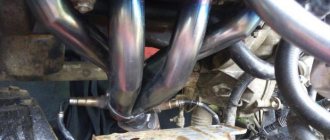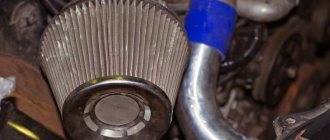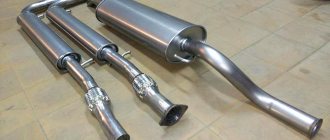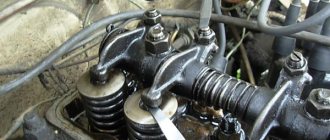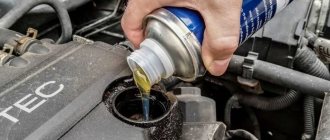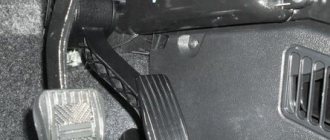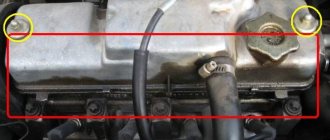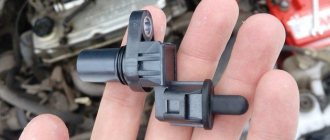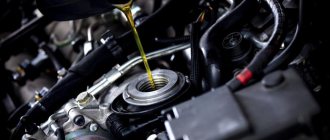Many car owners think about what a catalyst is in a car after this unit fails. Initially, catalytic converters began to be installed on cars to reduce the harmful effects on the environment of exhaust gases that are formed during the operation of internal combustion engines. However, not all drivers approve of the installation of neutralizers, because the cost of this unit is quite high. In addition, due to the low quality of gasoline, it has to be repaired regularly.
Automotive catalyst: what is it?
A catalytic converter is an element of the engine exhaust system designed to purify exhaust gases before releasing them into the atmosphere. The need to develop this component of a car engine arose in the 60s of the last century, when the world community became concerned about the state of the environment on the planet. At that time, the level of emissions from car exhaust pipes was not established at the legislative level.
The catalyst is designed to neutralize harmful vehicle emissions and is part of the vehicle exhaust system.
The first standards for the content of toxic products in vehicle emissions were introduced in 1970. Automakers were required to equip cars with devices that reduce the volume of carbon monoxide and hydrocarbon combustion products. Since 1975, the catalytic converter has become a mandatory part of all cars coming off the production line.
Manufacturers install three types of catalysts on cars:
- Ceramic - use a mechanical method of cleaning exhaust gases. They consist of ceramic plates coated with precious metals. The maximum service life of this type is 100 thousand kilometers. However, if the quality of the fuel is poor, its replacement is required after 70–80 thousand kilometers.
- Metal - their filling consists of metal honeycombs with increased elasticity. The design of such parts is reliable and more durable compared to ceramic catalysts.
- Sports models are the most reliable models, but at the same time they have a high cost. They are made of metal, but have greater throughput than the two previous options.
What is the catalyst for, and can it be cut out?
In Europe, the obligation to equip all cars with a catalytic converter (exhaust gas converter) dates back to the mid-1990s.
But, for example, in the USA they began to use catalysts much earlier, having timely realized that something needed to be done about harmful substances in vehicle exhaust gases. In our country, until the end of the 1990s, automakers had no obligation to install exhaust gas catalysts. And only with the advent of unified customs regulations everything began to change. As a result, today on the Russian market almost all new cars are equipped with catalytic converters. See also The inside of the car smells like rotten eggs: what happened?
The correct name for this component is catalytic converter because its operation is based on the reaction of substances contained in the exhaust gases with the catalyst. The catalytic substances in the exhaust system of a vehicle are most often precious metals.
Why do you need a catalytic converter in a car?
Most of the exhaust gases consist of completely neutral and harmless substances - nitrogen, water vapor and carbon dioxide. But it is almost impossible to get by with their presence alone; this only happens in a perfectly tuned engine operating in a predictable stationary mode.
In all other cases, the engine begins to emit chemically active substances that are extremely dangerous to humans, carbon monoxide, hydrocarbons and nitrogen oxides.
Direct destruction of such poisons at high speed and in the required volume is practically impossible, so engineers were forced to resort to catalytic reactions known from chemistry for processing harmful substances into relatively neutral ones.
In chemistry, a catalyst is a reaction component that participates in a process, accelerates it well, but is not consumed.
What it consists of and how it works
The basis of the catalyst is ceramic honeycomb
Structurally, the catalytic converter is a honeycomb-shaped ceramic substrate inserted into a metal casing and protected by heat-insulating materials. The small cells of the device have a special coating - the working composition. The composition covering the honeycomb is an alloy of platinum, rhodium and palladium, precious metals whose value is at least twice that of gold.
The honeycomb design of the catalyst increases the area of contact of toxic gases with the surface that neutralizes them. Remains of harmful substances burn out instantly and do not enter the atmosphere.
The catalyst consists of the following parts:
- Housing with inlet and outlet pipes;
- Ceramic block with a porous structure;
- Catalytic layer – spraying on the cells of a ceramic block;
- Sensor (lambda probe) – a device that shows the contamination of gases after cleaning;
- Metal casing - serves as thermal insulation and protects the housing from mechanical damage.
Sectional view of the catalyst device
The part is installed after the engine exhaust pipe or in the exhaust manifold flange. This arrangement is necessary for efficient operation of the catalyst, since neutralization of toxic substances is possible only at high temperatures. The node works as follows:
- Exhaust gases are directed through the inlet pipe into the part and onto the ceramic block, filling the cells.
- Catalyst metals oxidize unburned hydrocarbons and carbon monoxide.
- The reducing metal rhodium neutralizes nitric oxide and turns it into a harmless substance.
- Clean gas is released into the atmosphere through the outlet pipe.
It is important! The temperature of the process plays a decisive role in the process of neutralizing toxic substances. Conversion is possible at temperatures from 300 degrees, but generally the operating temperature of a car catalyst is in the range from 400 to 800 degrees.
When the engine warms up, the catalyst is inactive, and this is a significant drawback of the models developed to date. The difficulty in organizing the correct operation of the unit lies in the danger of its overheating. If the catalyst is located closer to the engine, the service life will sharply decrease due to systematic overheating. Most automakers place the part in the area of the right front wheel, where it is possible to maintain the temperature at an optimal level.
Brief information on precious metals used in catalysts
Platinum is a noble metal with a silvery-white color. The name platinum was given by the Spanish conquerors of South America. Due to the similarity of this metal to silver, but its very strong refractoriness, it was neglected and even drowned in the sea, separating gold from the placer; as a result, platinum in Spanish literally means the word “silver”, which is disparaging for silver.
The beginning of the use of platinum in catalysts was the discovery in 1821 by the German chemist I.V. Debereiner is the ability of platinum ore to occur and accelerate a number of chemical reactions, while the precious metal itself did not undergo any changes.
Rhodium is a noble precious metal of the platinum group with a brightly amazing cold shine of silvery-white color, expensive, very hard, but fragile.
A metal with such characteristics is the king of diamonds and gems, and is on a par in value with metals such as silver, gold and platinum. Rhodium is a metal obtained by processing platinum, and to obtain 1 kg of rhodium you need several tons of it.
The use of rhodium in mass quantities is mainly aimed at the automotive industry. About 97% of the raw material goes into the production of catalysts - components of the exhaust system. It is rhodium, which is a catalyst by nature, that is capable of processing toxic gases escaping from engine cylinders.
Palladium is a silvery-white transition metal with a face-centered cubic lattice; in its pure form, it is a rather soft metal.
Palladium is often used as a catalyst, mainly in the process of fat hydrogenation and petroleum cracking, and is currently actively used in the production of automotive catalysts.
Types of catalysts
According to its purpose, the neutralizer can be two- or three-component.
- In the first case, it performs the relatively simple functions of oxidizing (afterburning) carbon monoxide and hydrocarbons to form water and carbon dioxide.
- In the second, the device’s sophisticated ability to work with nitrogen oxides is added. Especially a lot of them are formed in modern diesel and gasoline engines, due to increased efficiency, the designers of which have to use lean and lean mixtures at the inlet.
Three-component catalysts, namely the ones most often used, in turn, can differ in design, being made on the basis of ceramic or metal honeycomb products.
Ceramic ones are relatively cheaper, but do not have high mechanical strength and durability, are prone to cracking and destruction, and do not withstand impacts when hitting obstacles.
Metal structures have sufficient elasticity, so they better withstand external and internal impacts. Internal ones can occur during abnormal combustion processes and have a destructive effect on the thin honeycomb filling, where, as already mentioned, such complex substances as platinum, palladium and rhodium are usually applied.
But even metal does not save you from the treacherous ingress of foreign substances from the engine into the thin honeycombs in the form of components of counterfeit working fluids, too rich a mixture or all kinds of silicon compounds.
Catalysts also differ in the way they are installed. Previously, they were located in the form of exhaust pipe inserts, like mufflers and resonators. But it turned out that it is very difficult and expensive to warm them up to the operating temperature at which catalytic reactions begin.
Therefore, now neutralizers are installed directly behind the exhaust manifold, as close as possible to the exit point of hot exhaust gases. You no longer have to wait long for the device to return to operating mode, oxygen sensors become less dirty and fuel consumption for maintaining temperature is reduced.
Operating principle of the catalyst
Exhaust gases are a mixture of NO (nitrogen oxide), CH (hydrocarbon), CO (carbon monoxide - carbon monoxide). These gases are dangerous both for the environment and for humans. Smog, which until recently was the hallmark of large cities, is formed due to the interaction of these and some other compounds, resulting in a smoke screen that is harmful to humans.
The principle of operation of the catalyst is based on oxidizing these elements through a catalytic reaction between the elements of gases and the catalyst alloy, resulting in either lower concentrations of harmful substances or pure oxygen and carbon dioxide.
The reaction occurs due to the high temperature of the exhaust gases (above 300 degrees). The higher the temperature, the faster the reaction occurs. The temperature of the exhaust gases largely depends on the fuel being filled. Low quality fuel can produce very high exhaust gas temperatures, which reduces the service life of the catalyst.
Catalyst life
Destruction of the ceramic block of the catalyst
The average service life of the catalyst is 100 thousand kilometers, but with proper operation it can function properly for up to 200 thousand kilometers. The main reasons for early wear are engine malfunction and fuel quality (fuel-air mixture). If the mixture is lean, overheating occurs, and if it is too rich, the porous block becomes clogged with remnants of unburned fuel, which prevents the necessary chemical processes from occurring. This leads to the fact that the service life of the catalytic converter is significantly reduced.
Another common cause of failure of a ceramic catalyst is mechanical damage (cracks) that occurs due to mechanical stress. They provoke rapid destruction of blocks.
If a malfunction occurs, the performance of the catalytic converter deteriorates, which is detected using a second lambda probe. In this case, the electronic control unit will report a malfunction by displaying the “CHECK ENGINE” error on the dashboard. Also signs of failure are rattling, increased fuel consumption and deterioration in dynamics. In this case, it is replaced with a new one (original production or universal). It is impossible to clean or restore catalysts, and since this device is expensive, many motorists prefer to simply remove it.
Characteristic features of the procedure
Before starting work, it is important to take into account certain features of removing the catalyst. Once the neutralizer is removed from the system, the sensor will begin to continuously detect the error.
To solve this problem, a deceptive design is most often made. It helps separate the sensor and exhaust gases. Therefore, the end result is a higher oxygen concentration. The screwing in of the blende takes place in the place of the former sensor, and the device must be installed here. The system is characterized by stable operation, despite the fact that it has a number of nuances:
Even minimal independent intervention in the vehicle design will deprive you of further warranty service. Therefore, you should first think about what actions will be taken if the engine is faulty when a warranty case occurs;
passing official maintenance becomes impossible. Cheating the on-board computer is half the battle. The truth will be revealed when the inspection takes place at a special stand. As a result, an official ban on the operation of the vehicle will be issued. You will have to return from the inspection station using a tow truck.
As an alternative, you can reflash the electronic control unit. Then the system will accept the existing indicators as the norm. To understand this issue, you need to have specialized knowledge and appropriate software.
It is important to understand that when using re-firmware, the existing cycles in the operation of the motor will begin to be disrupted. Therefore, the operating mode will become incorrect. As a result, the resource may decrease by at least half. Accordingly, we can conclude that saving on reflashing will only bring new and considerable financial expenses.
Causes of car catalyst malfunction
Companies that produce converters claim that they can be used for 100,000–150,000 km. However, in reality, this unit may fail much earlier, especially if you live in a metropolis and are constantly stuck in traffic jams.
Why can the neutralizer become unusable? The fact is that the car catalyst device is a filter. And the filter needs to be changed regularly.
The service life of the unit will be reduced if the ignition system is faulty. This problem is usually detected on Ford and VAZ cars. If the ignition is set incorrectly, misfires will occur. As a result, the fuel mixture will only partially burn. A huge amount of soot is formed, which accumulates in the neutralizer. The best solution is to clean it. But this will not help if the bobbin has melted.
Breakdown of this unit may occur if you use low-quality fuel. It will not burn completely. The afterburning process will occur in the collector and directly in the neutralizer. Microparticles will clog the filter and air will not be able to pass through it.
What indicates the need to replace the neutralizer?
The neutralizer models existing today for the most part have a safety margin of 100 to 120 thousand km, but an unexpected need for replacement may arise a little earlier.
A clear sign of the end of the service life of this device will be the burnout of the catalytic coating on the honeycomb. In modern car models, the on-board system immediately reports this problem - an error message lights up. If the vehicle is not new and does not have an on-board computer, the occurrence of a problem of this kind can be judged by the following signs:
- at high speeds, traction may temporarily, and sometimes permanently, disappear;
- The car starts very poorly, it takes a long time to operate the starter;
- suddenly, when the pedal is fully pressed, the speed stops rising above four thousand, and sometimes less, revolutions, while the car requires much more fuel.
Signs of a faulty car catalyst
How do you know if your car's exhaust system catalyst has become unusable?
- The “Check Engine” indicator lights up on the dashboard . It lights up if the system detects any engine error. In this situation, this occurs due to incorrect readings from the lambda probe sensor. To make sure that the cause of the malfunction is the catalyst, you need to diagnose it using a scanner.
- The car's power drops . If the catalyst in the car is not in order, the car will jerk, jerk, and traction will decrease. This happens because the throughput of the neutralizer has decreased. After all, the honeycombs were partially destroyed, they were baked, and the passage of exhaust gases was clogged. All this leads to the fact that the engine “does not breathe.”
- Extraneous sounds under the bottom . Do you hear knocking noises that occur at high speeds or when you start the car? This usually happens when the ceramic honeycomb begins to deteriorate. The fallen particles hit the walls of the catalyst, because they are affected by the gas flow, as well as centrifugal forces.
- Weak or even pressure of gases coming from the muffler . If the catalyst in the car is working normally, then by placing your palm on the exhaust pipe, you will feel that the outgoing flow of gases is pulsating. This happens because the exhaust valves work in turn. Have you noticed that the flow of gases is weak or there is no pulsation? This means that the neutralizer honeycombs are destroyed.
Why the neutralizer may fail
The catalytic device has a fairly long service life, and if destruction occurs within a short time after the vehicle is put into operation, then the vehicle has hidden problems with the power and ignition systems. Before replacing this device, a complete diagnosis of these systems is required.
If these systems do not operate correctly, complete combustion of the fuel does not occur in at least one of the cylinders, and the catalyst is forced to work in an enhanced mode, burning it out.
Very serious problems can be caused by high-voltage wires or coils and spark plugs. If the injectors malfunction, fuel may overflow, which also entails failure of the catalyst. If the rings and caps of the cylinder-piston system become stuck or worn out, the engine oil also begins to overflow and burn out.
As mentioned earlier, ceramic filling can be very easily damaged by mechanical stress. To avoid this situation, it would not hurt to install additional protection on the bottom of the car.
The destruction of the ceramic contents of the catalyst can cause crumbs to enter the engine cylinders, where they damage the walls and can even lead to engine failure. To prevent anything like this from happening, you need to monitor the condition of your vehicle and make the necessary repairs on time.
Poor quality fuel
If the mixture of gasoline and air does not completely burn in the engine cylinders, then combustion ends in the catalyst or in the exhaust manifold. Then the main parts of the exhaust system melt. Combustion products settle in the neutralizer and prevent gases from passing at the required speed. As a result, the system simply becomes clogged.
Low quality catalyst
Automakers equip cars with high-quality parts and consumables. But if something has changed in the car, it is not a fact that the owner was sold high-quality spare parts. If a low-quality or non-original converter is installed in a car, then there is a high risk that the catalyst cells are too small. Due to their insufficient size, they are easily clogged with fuel combustion products.
Often all signs of malfunction and symptoms of a clogged catalyst occur in American cars that were previously operated in the USA. In the United States, gas stations sell higher quality gasoline that leaves behind minimal unburned substances during the combustion process. Catalysts in such cars with small cells - in Russia they die in the shortest possible time.
Diesel engines
There is no catalyst on such power units. There is a particulate filter instead, it performs the same task as the catalytic converter in a gasoline engine. Another difference is the price. A particulate filter will cost three times more than a gasoline element.
The symptoms of a clogged catalyst on a diesel engine are similar to those that can be observed by owners of gasoline engines. This is a loss of power, the engine refuses to start, increased fuel consumption.
Is there another way to replace the old catalytic converter with a new one and get the benefits?
Certainly. For example, you can buy not an original factory catalyst, but a universal or sports exhaust gas converter, which for many car models cost much less than some original catalysts.
Some may be surprised by the combination of the words “catalyst” and “sport”, because it is well known that a catalyst has little in common with sports. But this is the opinion of amateurs and fans of street racing. In real motorsport, all sports cars must also comply with current legislation and therefore must be equipped with a catalytic converter. Even WRC cars, which usually have nothing in common with conventional road vehicles, have catalysts.
Expert opinion:
Artem Berkutov, expert at AutoExx exhaust system repair company:
– One of the cheaper alternatives to the original catalyst is to purchase a universal catalytic converter. True, there are risks. The aftermarket catalyst must fit perfectly into your vehicle's exhaust system. Unfortunately, it is not always possible to install a non-original catalyst. Moreover, even if the dimensions of the catalyst may be the same, it may not be suitable, for example, due to inaccurate dimensions (diameters) of the exhaust system pipes. Also, do not forget that installing a non-original catalyst may deprive the car owner of the factory warranty.
You also need to remember that gas flow control sensors (oxygen sensors), which worked perfectly with the original catalyst, may begin to function incorrectly in a non-original converter. For example, this may be due to differences in the analog catalyst capacity. Also, additional problems may appear in turbocharged engines.
And finally, the catalytic converter must comply with European emission standards (environmental class) established for your car, and also have working lambda probes installed in the same places as provided by the car manufacturer. If we take into account all the conditions that must be met when installing a non-original catalyst in order for the exhaust gas cleaning process to proceed correctly, the question arises: is it not better to pay more to buy an original catalyst, instead of purchasing an analog component, which can have a lot of problems? ?
See also: How does exhaust back pressure affect car power?
However, if the cost of purchasing a new catalyst is unacceptable to you, you have two options: cut out the catalyst, installing instead a simple pipe, plug, etc., equipping the exhaust system with lambda probes, or purchase a non-original converter. In this case, you cannot do without qualified help. Contact a specialist who will advise you and tell you whether it makes sense to cut out or buy a non-original catalyst for your car.
Verification methods
But before sinning on the device, you should make sure that the problem is hidden in it.
Checking the catalyst is carried out in two ways - without removing it from the car, and after dismantling it.
Check without removal.
Without removing it from the car, the device is checked in two ways - by diagnosing the exhaust system using a gas analyzer and testing for back pressure in the gas exhaust system.
Although checking with a gas analyzer is an excellent option, not all service stations are equipped with such equipment. But in small towns you won’t find such a device at all.
The essence of this method is that a gas analyzer is connected to the exhaust pipe of the car and measurements are taken.
Based on a chemical analysis of the exhaust gases, it is determined whether the catalyst is clogged or not.
The second test method, for back pressure, is more common and does not require complex equipment.
The essence of this test is to determine the pressure at the inlet to the converter. If it is clogged, the pressure in front of it will increase at certain engine speeds.
Officially, this testing method is done like this: a hole is made in the pipe leading to the neutralizer, into which a thread is cut. Next, a fitting is screwed into this hole, to which a copper tube is connected.
It is needed to dissipate the heat received from the exhaust system. A rubber hose is attached to the end of the copper tube and connected to a pressure gauge.
Having made such a device, we begin to take measurements. The exhaust system is tested in all engine operating modes, and the pressure gauge readings determine whether the catalyst is clogged.
By the way, special kits are sold for testing using countermeasures.
This method is somewhat complicated to implement - you need to drill a pipe, cut a thread, and after taking measurements, look for a suitable plug to close the hole.
Ways to solve the problem
Just checking the catalyst is not enough, because if it is clogged, the problem needs to be solved.
There are several options to troubleshoot the problem:
- Try to clean or rinse the device. This can really help, but only in case of minor blockage. If the honeycombs are melted, destroyed or completely blocked, the problem cannot be solved in this way.
- Replacement of the neutralizer with the original one. The easiest way to do it is to remove it, install a new one and that’s it. But the original analogue is very expensive, so it is not always advisable to buy it.
- Replacement with a universal neutralizer. Some companies engaged in the production of auto parts and accessories produce catalytic converters that can be installed on different cars. Such an element costs less than the original one, but you will have to “suffer” with the selection and adjustment;
- Replacing the neutralizer with a flame arrester. The easiest way to forget about the catalyst problem forever.
The flame arrester crashes into the system instead of the neutralizer and that’s it. But for the ECU to work correctly, you will have to either reflash it or use tricks. It is worth noting that you can no longer drive a car that has a flame arrester instead of a neutralizer into some European countries.
How to solve a problem with a catalytic converter is up to the car owner to decide. We told you how to check this element in different ways, and what can be done if it malfunctions.
Latest innovations in technical inspection
In March 2022, the government tightened the rules for passing technical inspection of vehicles. Therefore, specialized services began to upgrade existing equipment in order to prepare for upcoming inspections. Diagnostic cards began to be issued in electronic form. In this document, specialists must upload photographs of the car. It should display the following data:
license plate on the stand;
GPS coordinates.
Attention: in case of recorded violations, large fines were introduced, including criminal penalties. Thus, purchasing a vehicle inspection has become quite an expensive pleasure.
It is also mandatory to obtain a diagnostic card if the owner of the car has changed, a major component has been replaced, or changes have been made to a structural element. This rule only applies to cars older than 4 years.
Let's sum it up
Taking into account the above information, it becomes clear that in modern cars the catalyst is an important element, which, in conjunction with an oxygen sensor, has a direct impact on mixture formation and engine operation as a whole. Also, problems with the catalyst can lead to malfunctions of the internal combustion engine if the filter is clogged.
We also recommend reading the article on how to repair a car muffler yourself. In this article, you will learn how to repair a muffler if this element of your vehicle's exhaust system fails or is damaged. For this reason, you should pay attention to any signs that may indicate a faulty catalytic converter. The fact is that there are often cases when parts of destroyed elements of the exhaust gas converter got into the engine with all the ensuing consequences.
Finally, we note that replacing the catalytic converter is the most correct solution, however, if you do not have the funds to purchase a new part, you can limit yourself to installing a flame arrester. Although the level of exhaust toxicity in this case increases greatly and does not meet the norms and standards, the owner gets the opportunity to normally operate a car with a properly functioning internal combustion engine.
Sources
- https://rad-star.ru/pressroom/articles/chto-takoe-katalizator-v-avto/
- https://carnovato.ru/chto-takoe-katalizator-v-avtomobile/
- https://AutoVogdenie.ru/chto-takoe-katalizator-v-avtomobile.html
- https://glushak.ru/articles/obshaya-informaciya-o-katalizatorah/
- https://TechAutoPort.ru/dvigatel/vypusknaya-sistema/kataliticheskiy-neytralizator.html
- https://DriverTip.ru/osnovy/katalizator-v-avtomobile-i-zachem-on-nuzhen.html
- https://FB.ru/article/278049/zabityiy-katalizator-simptomyi-sposobyi-ustraneniya-problemyi-i-rekomendatsii
- https://AutoTopik.ru/sovet/1003-kak-proverit-katalizator.html
- https://KrutiMotor.ru/priznaki-zabitogo-katalizatora/
How to diagnose performance?
You can determine the performance of a car’s catalyst on your own or at a service center. There are three methods to check the functionality of a given node:
- Inspection of the hull. If the catalyst body is deformed, we can talk about partial or complete failure of the unit. The catalyst needs to be removed and held up to light. Certain models do not allow inspection unless the case is opened.
- Back pressure. To check, you will need a pressure gauge and an adapter tube to connect to it. The pressure gauge is mounted on the position of the lambda probe and the engine is started at 2.5-3 thousand revolutions for 15 seconds. Normal pressure parameters are 0.3-0.35 kg/cm2. If the indicator value is from 0.5 kg/cm2, we can talk about problems with the catalyst.
- Motor tester for diagnostics. This option can be implemented using specialized equipment. The device is connected to the place of the spark plugs to take readings when the engine starts.
